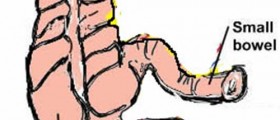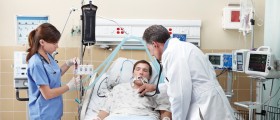Appendicitis - Overview
Appendicitis is a medical term which refers to inflammation of the appendix, a small pouch attached to the cecum which is the proximal part of the large intestine. The actual function of the appendix is not known but this tiny little organ can easily get inflamed and eventually rupture causing serious complications. Rupture of the inflamed appendix is a medical emergency and requires prompt surgical care since if left untreated it definitely leads to death.
Appendicitis typically features with pain in the abdomen. Since there are so many causes of abdominal pain, diagnosing appendicitis can be rather challenging. The pain is usually located in the lower right segment of the abdomen although it may also radiate toward the right leg. The complete blood count points to high number of white blood cells which may help in setting of the diagnosis. Timely diagnosing of appendicitis is essential in prevention of its rupture an occurrence of many complications.

When the appendix is about to rupture the patients may report a sharp pain around the belly button. The pain is usually accompanied by throbbing contractions of abdominal muscles and nausea. It intensifies with any kind of movement. Rigidity of the abdomen points to irritation of the peritoneum and its presence may be an indicator of the rupture.
The initial pain represents a referred pain resulting from the visceral innervation of the midgut, and the localised pain is caused by involvement of the parietal peritoneum after progression of the inflammatory process. Loss of appetite is often a predominant feature, and constipation and nausea are often present. Profuse vomiting may indicate development of generalized peritonitis after perforation but is rarely a major feature in simple appendicitis.
- Patients at the extremes of age have increased mortality because of late presentation or subtle signs.
- Computed tomography scanning is more sensitive and specific than ultrasonography when diagnosing acute appendicitis.
- Laparoscopic appendicectomy is becoming increasingly common, and clinical evidence suggests that it has some advantages over open surgery.
- Wound infections can be decreased with the use of perioperative antibiotics.
- The vermiform appendix is a tubular structure attached to the base of the caecum at the confluence of the taeniae coli. It is approximately 8-10 cm long in adults and represents the underdeveloped distal end of the large caecum seen in other animals. In humans it is regarded as a vestigial organ, and acute inflammation of this structure is called acute appendicitis.
- Appendicectomy is a relatively safe procedure with a mortality rate for non-perforated appendicitis of 0.8 per 1000. The mortality and morbidity are related to the stage of disease and increase in cases of perforation; mortality after perforation is 5.1 per 1000. As stated above, the average rate of perforation at presentation is between 16% and 30%, but this is significantly increased in elderly people and young children, in whom the rate can be up to 97%, usually because of a delay in diagnosis.
- The rate of postoperative wound infection is determined by the intraoperative wound contamination. Rates of infection vary from
Complications of Ruptured Appendix
The correct diagnosis of ruptured appendix can be set only after other medical conditions related to abdominal organs are ruled out. Relevant data for diagnosing the rupture include exact location of the pain, its radiation and additional symptoms. Diagnosing rupture of the appendix may be difficult even for a well experienced doctor.
One complication of the ruptured appendix is peritonitis. Peritonitis is an inflammation of the peritoneum and in this case it is caused by bacteria which originate from the appendix. The entire stomach becomes rigid and patients usually complain about severe pain. They also suffer from fever and white blood cells drastically increase in number. This complication requires prompt surgery and the goal of the surgery is to clear the entire peritoneal cavity, flush it properly, and make sure the infection does not spread to the blood and cause septicemia.
One more complication of ruptured appendix is formation of abdominal abscesses. These are collections of puss accumulated in a cavity formed by the tissues around the puss. This condition also requires surgery and the goal is drainage of the abscess.
And finally, the last complication of ruptured appendix is death. The lethal outcome is basically connected to the spread of the bacteria in the blood stream and the occurrence of septicemia.

















Your thoughts on this
Loading...